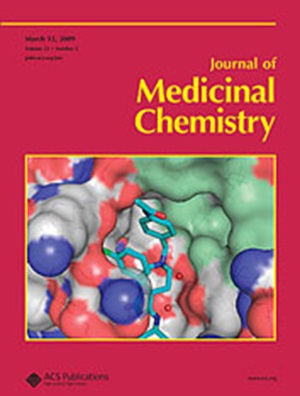巴比妥酸衍生物作为巴西利什曼原虫二氢化脱氢酶共价抑制剂的研究。
IF 6.8
1区 医学
Q1 CHEMISTRY, MEDICINAL
引用次数: 0
摘要
应用于寄生虫蛋白的共价药物设计可以通过靶向大分子的亲核残基来实现选择性治疗。我们提出了巴西利什曼原虫二氢酸脱氢酶(LbDHODH)的第一个共价抑制剂,该酶是嘧啶生物合成的关键酶,活性位点有活性半胱氨酸(Cys131)。从巴比妥酸衍生物中,我们发现2i是一种LbDHODH抑制剂,具有杀灭利什曼尼的活性,IC50为0.5±0.1 μM, Kinact/KI为767 M-1s-1,对人类同源物无抑制作用,对巴西L. promastigotes的EC50为11±5 μM,对THP-1细胞无细胞毒性,具有良好的被动通透性。x射线晶体学证实与Cys131形成共价键,并显示活性位点重排。这些发现支持了所提出的共价抑制机制,并为进一步优化提供了结构见解。我们的研究证实了LbDHODH是治疗利什曼病的一个有希望的靶点,并强调了共价抑制在抗寄生虫药物发现中的潜力。本文章由计算机程序翻译,如有差异,请以英文原文为准。
Barbituric Acid Derivatives as Covalent Inhibitors of Leishmania braziliensis Dihydroorotate Dehydrogenase.
Covalent drug design applied to parasite proteins enables selective therapies by targeting nucleophilic residues of macromolecules. We present the first covalent inhibitors of Leishmania braziliensis dihydroorotate dehydrogenase (LbDHODH), a key enzyme in pyrimidine biosynthesis with a reactive cysteine (Cys131) in its active site. From barbituric acid derivatives, we discovered 2i as a LbDHODH inhibitor with leishmanicidal activity, exhibiting an IC50 of 0.5 ± 0.1 μM, a Kinact/KI of 767 M-1s-1, no inhibition of the human ortholog, and an EC50 of 11 ± 5 μM in L. braziliensis promastigotes, with no cytotoxicity in THP-1 cells and good passive permeability. X-ray crystallography confirms covalent bond formation with Cys131 and reveals active-site rearrangements. These findings support the proposed covalent inhibition mechanism and provide structural insights for further optimization. Our study validates LbDHODH as a promising target for leishmaniasis therapy and highlights the potential of covalent inhibition in antiparasitic drug discovery.
求助全文
通过发布文献求助,成功后即可免费获取论文全文。
去求助
来源期刊

Journal of Medicinal Chemistry
医学-医药化学
CiteScore
4.00
自引率
11.00%
发文量
804
审稿时长
1.9 months
期刊介绍:
The Journal of Medicinal Chemistry is a prestigious biweekly peer-reviewed publication that focuses on the multifaceted field of medicinal chemistry. Since its inception in 1959 as the Journal of Medicinal and Pharmaceutical Chemistry, it has evolved to become a cornerstone in the dissemination of research findings related to the design, synthesis, and development of therapeutic agents.
The Journal of Medicinal Chemistry is recognized for its significant impact in the scientific community, as evidenced by its 2022 impact factor of 7.3. This metric reflects the journal's influence and the importance of its content in shaping the future of drug discovery and development. The journal serves as a vital resource for chemists, pharmacologists, and other researchers interested in the molecular mechanisms of drug action and the optimization of therapeutic compounds.
 求助内容:
求助内容: 应助结果提醒方式:
应助结果提醒方式:


